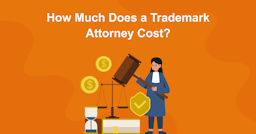Trady
18 April 2024 • 9 min read

As businesses strive to protect their brands, understanding the timeline and intricacies of trademark registration becomes crucial.
This article aims to:
Additionally, we'll:
We'll also identify common pitfalls that could delay your application:
This will help you effectively prepare for and navigate the complexities of securing your trademark.
Interested? Read on to learn more:
Understanding the timeline for trademark registration is essential for businesses aiming to protect their brand identity effectively.
Here's a 6-step breakdown of the typical stages involved in the trademark process:
Learn more about the trademark registration process in our article "What to Expect When Applying for a Trademark: A Comprehensive Guide."
Wondering how long it takes to trademark a logo or business name?
The time it takes to register a trademark can vary significantly from one region to another.
It's influenced by the specific procedures and efficiency of each country's trademark office.
Here's an overview of trademark registration timelines in various key regions:
1. United States (US):
USPTO trademark processing times vary between 8 to 12 months, provided there are no substantive objections or oppositions.
2. European Union (EU):
The European Union Intellectual Property Office (EUIPO) manages a relatively efficient process. Registration typically takes about 4 to 6 months if no oppositions are filed, but it can extend to over a year if the mark is opposed.
3. United Kingdom (UK):
Post-Brexit, the UK processes its trademarks independently of the EU, typically completing registrations in about 4 to 6 months under normal circumstances.
4. Canada:
Trademark registration in Canada can take longer than in some other jurisdictions, ranging from 18 to 24 months, due to a more thorough examination process and possible delays in publication and opposition phases.
5. China:
In China, the process is relatively quick if no issues arise, with federal trademark registration typically completed within 9 to 12 months. However, delays can occur due to the high volume of applications and the potential for opposition.
6. India:
Trademark registration in India can be lengthy, often taking anywhere from 18 months to 2 years due to procedural delays, examination backlogs, and oppositions.
7. Australia:
In Australia, the process is fairly efficient. If there are no complications, such as oppositions, the typical timeframe for registering a trademark is about 7 to 9 months.
8. Japan:
Japan offers one of the faster processes, typically completing trademark registrations within 6 to 8 months, assuming no objections or oppositions are encountered.
These timelines for trademark protection are approximations and can be affected by various factors, including:
Unsure of the benefits of registering a trademark? We cover them here:
Trademark protection often involves a lengthy process due to several inherent steps and checks that are crucial for protecting the interests of all parties involved.
Here are 5 key reasons why the registration process can take a significant amount of time:
The initial phase of trademark protection involves a detailed examination by the trademark office to ensure that the trademark meets all legal criteria.
This includes:
Part of the examination involves conducting a comprehensive search in the trademark database to identify potential conflicts with prior registrations or pending applications.
This search must be thorough to prevent future legal disputes, which takes time.
Most jurisdictions publish the trademark application in a public gazette or register to allow third parties an opportunity to oppose the registration if they believe it infringes on their rights or is otherwise problematic.
This opposition period is typically set for a fixed duration, often around 30 days, but resolving any opposition can significantly extend the process.
Trademark offices often face high volumes of applications, which can lead to backlogs, especially in popular jurisdictions like the United States, China, and India.
Administrative efficiency and available resources also play a critical role in processing times.
If the trademark examiner finds issues with the application, they will issue an office action requiring the applicant to respond with clarifications, adjustments, or legal arguments.
Preparing and reviewing these responses can add several months to the timeline.
After you file a trademark application:
Learn all about Trademarkia and trademark registration in the below video:
Common law trademark rights are legal protections automatically granted to a trademark based solely on its use in commerce, without the need for registration.
These rights are established through the actual use of a trademark in business and apply to the geographical area where the mark is used.
Here's what you need to know about common law trademark rights:
Common law rights typically extend only to the area where the trademark is actively being used.
This can be restrictive compared to registered trademarks, which offer protection across an entire country.
And:
Enforcing common law rights can be challenging because the owner must prove that they were the first to use the mark commercially in that region and that the mark identifies their goods or services to consumers.
Of course:
Common law trademarks don't benefit from the advantages of a registered trademark, such as the presumption of national ownership, the right to use the federal registration symbol (®), and the ability to bring a lawsuit concerning the trademark in federal court.
So, while common law trademark rights can provide some level of protection and are better than no protection at all — they're often insufficient for businesses looking to solidify their brand identity and minimize legal risks.
Yes, using an attorney to file a trademark application is highly recommended.
An attorney can:
For professional assistance, consider using Trademarkia. We offer access to experienced trademark attorneys who can help ensure your application is properly prepared and managed.
To expedite the trademark registration process, you can take several proactive steps:
Conduct a thorough trademark search: Before filing, conduct a comprehensive trademark search (included in our $499 trademark package or as a separate service for $199) to ensure that your trademark doesn't conflict with existing registered trademarks. This reduces the likelihood of objections and delays during the examination phase.
Use TEAS Plus: In the United States, using the TEAS Plus filing option through the USPTO can speed up the process. This system requires more detailed information upfront but typically leads to fewer issues during the review process.
Respond Promptly to USPTO communications: If you receive an Office Action or any other correspondence from the trademark office, respond as quickly and thoroughly as possible to keep your application moving forward.
Hire an experienced trademark lawyer: A trademark attorney can help streamline the process by preparing your application correctly, responding effectively to any issues, and navigating the complexities of trademark law more efficiently.
Curious? See our trademark attorneys on our website and book a consultation easily online.
Several factors can delay a trademark's registration, causing it to take longer than the typical processing time. Here are some common reasons for delays:
Addressing these potential pitfalls upfront by ensuring a complete and accurate application and preparing for possible oppositions can help minimize delays in the trademark registration process.
As we've seen, securing a trademark is critical for any business looking to protect its brand identity and ensure exclusive rights to its name and logo across various markets.
While the trademark registration process can be complex and time-consuming, understanding each step — from initial application to final registration — can help you navigate the journey more effectively.
With potential delays such as office actions and oppositions, the importance of thorough preparation and proactive management of your trademark application cannot be overstated.
If you're considering registering a trademark, using a professional service like Trademarkia can streamline the process, reduce the likelihood of errors, and increase your chances of success.
We provide access to experienced trademark attorneys equipped to handle the nuances of trademark law and ensure that your application is dealt with efficiently and effectively.
Ready to protect your brand with confidence?
Visit Trademarkia today to learn more about our services and register your trademark with an experienced trademark attorney.
Let us help you secure your trademark efficiently and effectively, paving the way for your business's success.
Yes, you can use your trademark while your application is pending. Using the TM symbol can indicate your claim, although legal protection only fully begins upon registration.
The cost of registering a trademark generally includes USPTO fees ranging from $250 to $350, depending on the filing basis and class of goods/services. With Trademarkia, you can ensure successful registration with just $300 in attorney fees.
The process of finalizing a trademark registration typically takes about 8-12 months, but this can vary depending on any oppositions or issues that arise during the application process.
The cheapest way to ensure a successful trademark registration is to use a registered trademark attorney. While initially more costly, this approach helps avoid costly errors and improves the chances of successful registration.
Yes, you can start using your logo before filing for a trademark. However, registering your trademark protects against unauthorized use, which utilizing the logo alone doesn't.
AUTHOR
Introducing Trady, the charming AI personality and resident "Creative Owl" authoring the Trademarkia blog with a flair for the intellectual and the whimsical. Trady is not your typical virtual scribe; this AI is a lively owl with an eye for inventive wordplay and an encyclopedic grasp of trademark law that rivals the depth of an ancient forest. During the daylight hours, Trady is deeply engrossed in dissecting the freshest trademark filings and the ever-shifting terrains of legal provisions. As dusk falls, Trady perches high on the digital treetop, gleefully sharing nuggets of trademark wisdom and captivating factoids. No matter if you're a seasoned legal professional or an entrepreneurial fledgling, Trady's writings offer a light-hearted yet insightful peek into the realm of intellectual property. Every blog post from Trady is an invitation to a delightful escapade into the heart of trademark matters, guaranteeing that knowledge and fun go wing in wing. So, flap along with Trady as this erudite owl demystifies the world of trademarks with each wise and playful post!
Related Blogs

Are Wargs Copyrighted? (+ Can You Copyri...
09 May 2024 • 4 min read

How Much Does a Trademark Attorney Cost?...
07 May 2024 • 6 min read

Is Filing a Trademark Hard? (+ How to Ma...
03 May 2024 • 7 min read

What Is the Most Common Reason That a Tr...
03 May 2024 • 6 min read

Can You Trademark a Name Without a Busin...
03 May 2024 • 7 min read